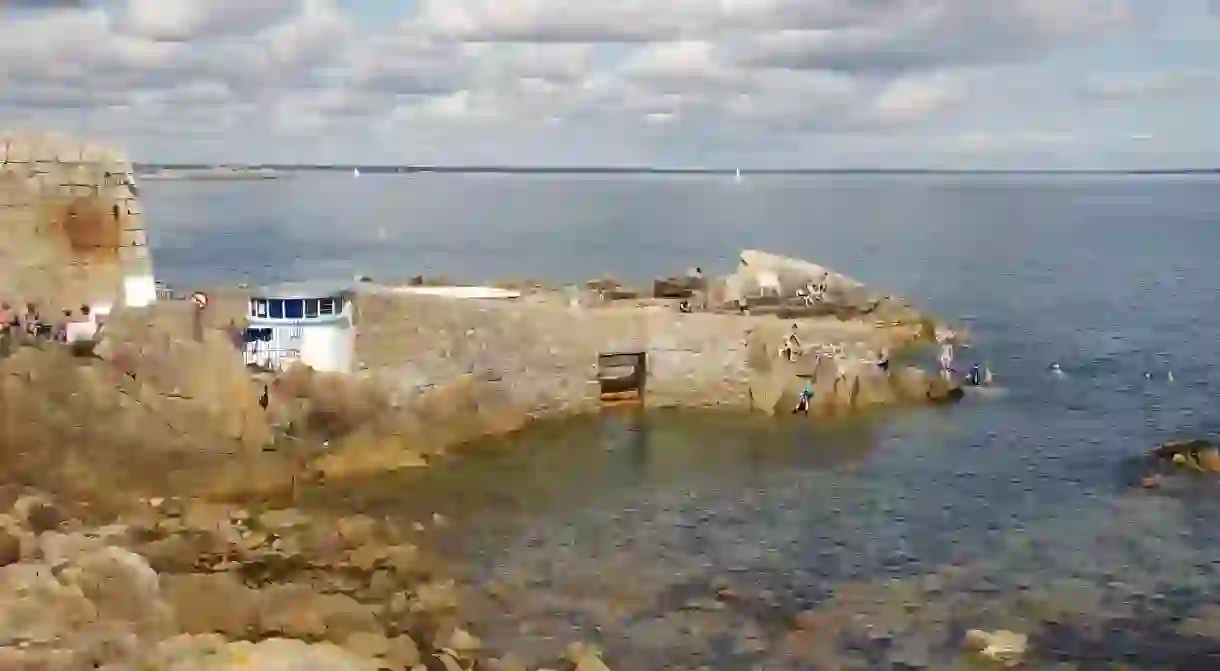Top Things to Do in Dún Laoghaire, Dublin

The seaside suburb of Dún Laoghaire, on the edge of Dublin and centred around one of the largest harbours in Ireland, offers an array of activity options, both leisurely and energetic. Historically, Dún Laoghaire was a fort from which the fifth-century High King of Ireland, Laoghaire Mac Néill, conducted his European raids. A waterbaby’s dream, today the coastal town has a more peaceful vibe, and a visit provides an insight into Dublin’s history as a port as well as a chance to take a dip in the sea. Did you know – Culture Trip now does bookable, small-group trips? Pick from authentic, immersive Epic Trips, compact and action-packed Mini Trips and sparkling, expansive Sailing Trips.
East Pier

Dún Laoghaire harbour’s East Pier is more than 1km (½mi) long and the preferred spot for a stroll among locals and office workers – or you. Jutting purposefully out into Dublin Bay, it affords stunning views across the water to the Howth Head peninsula, its northern counterpart. It also boasts a beautifully restored bandstand. Marking the boats’ entrance to the harbour stands the East Pier lighthouse, long automated but retaining its historic charm.
National Maritime Museum of Ireland

Ireland’s National Maritime Museum occupies a former mariners’ church, one of the few left standing in the world. Purpose-built to give sailors a place to pray, it has been lovingly maintained – the only thing, from the outside, identifying it as retired is a huge anchor in the yard. It houses several exhibits, including a recreated ship’s radio room, a Titanic exhibition and items from the wreck of the RMS Leinster, torpedoed in 1918 off the Dún Laoghaire coast. The Maritime Café inside is also one of the town’s best lunch spots, stocking healthy vegan and vegetarian fare.
Dublin Bay Cruises

The lush landscapes surrounding Dún Laoghaire can’t be overstated. While the views can certainly be enjoyed on a walk down the promenade, a boat trip across the bay is the best way to see them in all their glory. Dublin Bay Cruises provide award-winning ferry trips back and forth from Dún Laoghaire to the city centre, Howth and Dalkey Island. From the sea, the splendour of the Dublin mountains, Eye island, Lambay Island, Dalkey Island and Howth’s Baily Lighthouse can truly be appreciated.
The James Joyce Tower and Museum

Dublin’s Martello towers were built to protect against invasion by Napoleon, but many have gone on to serve other purposes, such as this one in Sandycove. Having once housed one of Ireland’s best-known writers, James Joyce, for all of six nights, it was featured in his famous novel Ulysses. It has since been dedicated to his memory with a museum celebrating his life and works. The display includes letters and photographs belonging to Joyce, and the living room has been dutifully kept to fit the book’s description.
Pavilion Theatre

With an active roster of theatre, literature, comedy, dance and music throughout the year, the Pavilion Theatre always has a cultural event worth seeing. The original theatre was built in 1903, surrounded by lavish gardens and even had its own small waterfall; it was destroyed by fire in 1915, as was the subsequent one. Today’s theatre, which opened in 2001, stands on the same site. If the Irish weather doesn’t cooperate, the cinema is a great place to camp out, with an exciting programme of art-house, independent and classic films. It also screens films for the annual Dublin Animation Film Festival.
Scuba diving with Oceandivers

From early April to mid-October visitors to Dún Laoghaire have the chance to explore two of Ireland’s best diving sites: Dalkey Island and the Muglins rocks. In good conditions, both sites offer the potential to see a wealth of Irish marine life at depths of 8m-25m (25ft-80ft), from sponges and starfish to crab, lobster and dogfish. Oceandivers diving school is run by two of Ireland’s first Professional Association of Diving Instructors (Padi) with more than 20 years’ experience teaching, so even novices are in good hands here.
Forty Foot promontory

Once it was for men only, but today the 250-year-old Forty Foot promontory is for all Dubliners a favourite place to swim. In the 1970s, the former gentlemen’s bathing place became part of the women’s liberation movement when female activists staged a protest by jumping into its waters. It has featured in famous Irish novels such as James Joyce’s Ulysses, and is especially popular with older swimmers, some of whom swim here every day. (Many believe swimming in icy Irish water during winter promotes good health.)
People’s Park

A quaint landscaped park near the seafront, the People’s Park is a great place to bring a picnic or just to unwind. It’s open daily, as is the Fallon & Byrne restaurant in the Victorian park shelter that was once the park tearooms. A sister of the upmarket restaurant and food hall that has become a city-centre staple, it has a veranda overlooking the park that is an ideal setting for a special occasion. On Sundays the park is taken over by a colourful farmer’s market, selling fresh produce from Ireland and abroad.
The Oratory of the Sacred Heart
Created to celebrate the end of the First World War, the Oratory of the Sacred Heart has survived the Dominican convent it was once part of. It is home to a statue donated by a French town in memory of Irish soldiers and is beautifully decorated. As well as having several stained-glass windows created by artist Harry Clarke, the entirety of its walls and ceilings were hand-painted with symbols associated with the Gaelic revival by a nun called Sister Concepta Lynch, which took her 16 years.













